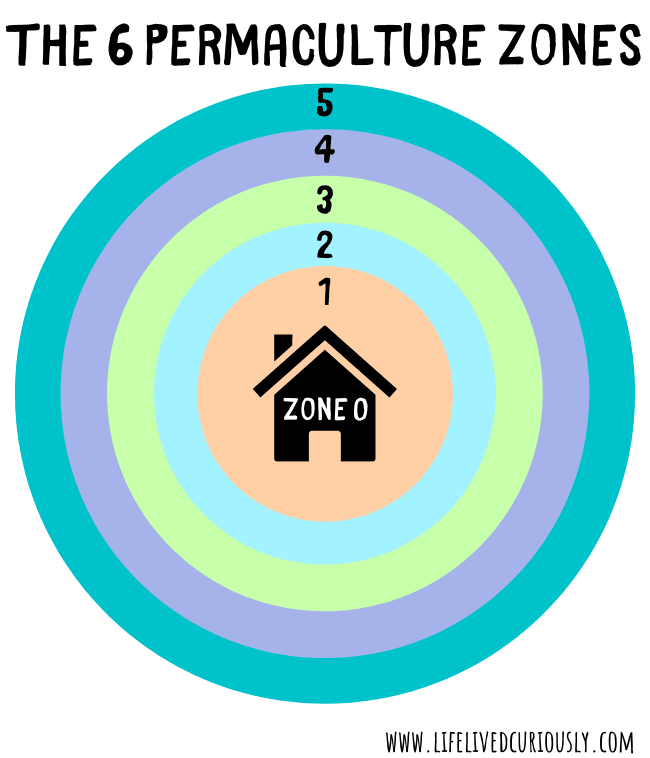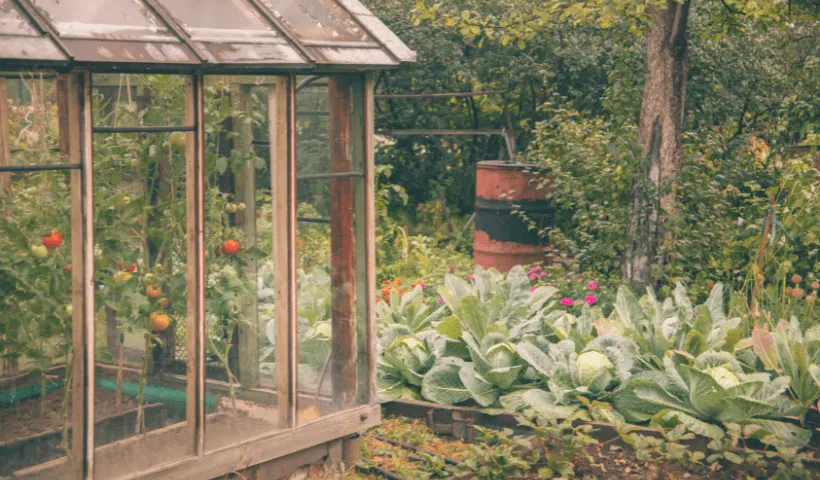When designing a property following permaculture principles, it’s common to use “the zone approach.” This means dividing a property into defined zones based on proximity to the main dwelling and the intended use of each area.
As we go into more detail throughout this article, you’ll see that, similar to much of permaculture theory, zones can be interpreted and defined differently to accommodate everyone’s preferences and situations.
Before we go any further, let’s get a mini-refresher on what permaculture is.
Permaculture is a way to meet human needs through regenerative design and management of land.
It integrates land, resources, people, and the environment through mutually beneficial synergies, imitating the closed-loop, no-waste systems seen in diverse natural ecosystems.
Here at Life Lived Curiously, we define permaculture as: “An integration of ecological components and processes into human-directed applications that solve wants and needs sustainably, creating a richer, more productive environment as a result.“
Keep this definition in mind as we learn more about the 6 permaculture zones and how to use them on your property!
If you’re just starting to learn about permaculture or need a longer refresher, check out our introductory article What Is Permaculture? An Introduction To Regenerative Gardening. We also wrote The 12 Permaculture Principles and The 5 Best Permaculture Books to Read in 2022.
What Are Permaculture Zones?
Simply put, permaculture zones label and designate areas of a landscape according to ease and frequency of use. The zones go from low (00), the most regularly used areas and features of a property, to high (5), the least visited and most isolated areas.
Zones are an organizational tool that emphasizes positioning time and care-intensive elements of a property as close as possible to the center of human activity. In the same token, features that require little to no maintenance are purposefully positioned in the zone furthest away from the home or human hub.
Although there are several different interpretations of how many and what each zone should represent, my favorite and the most sensible is from Ben Falk in his book The Resilient Farm and Homestead. The following list is a direct excerpt from his book.
00 – The human being, physical, meant, and spiritual: body, mind, self. This is the space you occupy every moment of every day.
0 – The home shelter: house and kitchen area especially. These are the spaces you occupy many times each day. On a well-designed homestead, this includes outdoor living space near the dwelling.
1 – The most often used landscape areas: vegetable garden, barn, parking areas.
2 – Lesser-used areas that are frequented once to twice a day or so: typically, some staple annual crops such as potatoes: perennials, such as fruit trees and berries; grazing areas; mushroom yards.
3 – Areas frequented a few times a week: typically, grazing paddocks, most orchards, mushroom yards, and nutteries.
4 – The least frequented areas under management: wood-lots, some grazing areas, some forest garden zones.
5 – Unmanaged land: “wild.” Land that is left for observation alone – one visits but does not cut, harvest, or forage in any significant way. Not all or even most sites may have a true zone 5.
As you can see, the zones are defined by how often an area is used, and how close they are to the home space of a property. Keep reading to see why this is important and how it can help you design your own permaculture space.
One important thing to note, which is a recurring theme throughout permaculture, is that zones are flexible in their definition. As Ben Falk says:
“Zone definitions vary significantly with overall occupants per acre of the site. For example, a family on a quarter-acre will often visit zone 3 multiple times per day, whereas zone 3 on a rural homestead of ten acres with a handful of people often only sees a visitor a few times per week or less. Variation with the season is also enormous, and the definitions above are for growing-season periods: I visit zone 3 in the winter less than once a week and sometimes only once a month.”

How Are Permaculture Zones Helpful?
Permaculture zones offer simple and straightforward guidelines on how to organize and design your property to maximize energy efficiency. Once designated and defined, they offer clear direction on not only where permaculture elements should be placed, but also how you should spend your time.
If something, say a food plot or a water source, is placed in zone 1 because it is used daily, then it’s safe to assume that you should be spending a notable amount of time caring and maintaining for that space. This line of thinking will help create daily, weekly, and monthly task lists and schedules.
And while efficiency is the main benefit of creating zones, they’re also incredibly useful when creating and planning new projects or changes to your landscape.
As you probably know, not everything in a landscape can (or should) be imagined, planned, and executed at the same time. So, when locations for certain types of activities and projects are already allocated, it gives you an idea of how much space is available, how much theoretical commitment you already have to other tasks, and a sense of if your zones need to be redefined or redrawn.
When you create zones, and especially if you draw up a map of your property, you set yourself up for future success.
Who Should Use Permaculture Zones?
Whether you’re growing a vegetable garden, a multi-acre integrated food forest, or are just getting your feet wet on a new property, zones will help you achieve your permaculture goals.
In my opinion, they are most helpful for areas of land that are one acre or bigger. While land that is less than an area can be extremely productive and healthy, there just isn’t enough space to encompass many of the permaculture zones in their true intentions.
But don’t let this deter you! This is simply my own opinion. Additionally, as stated above, zones are highly flexible in their definitions, and can certainly be adapted to be helpful in a small yard.
Let’s dive a little deeper into each zone and how you can incorporate them into your land.

The 6 Permaculture Zones
Zone 00-0
I am lumping zone 00 and 0 together because they are very similar and most permaculture authorities do not actually talk about zone 00.
This is the human hub of the property and where you spend most of your “daily living” time. This includes you, your family, your home, and any outdoor living spaces connected to or near the home.
To me, zone 0 encompasses all of the basic necessities needed to make a home operational, in the most stripped-down, fundamental ways. Some essential components humans need in their home include a bathroom, a shower, a kitchen, and a living space. These may occupy space indoors or outdoors, or maybe even both.
Going a step further than that, to make these components operational, a house must have a water source, an energy source, and a way to dispose of waste. Rain catchment systems, wells, greywater systems, solar panels, generators, dried wood, propane or oil tanks, etc. will most likely, and in my opinion, should, be located in or as close as possible to zone 0.
Zone 1
Zone 1 encompasses the first, and most essential, tier of intentional landscaping and cultivation. Here, you’ll find vegetable plots, herb gardens, chicken coops, barns or sheds, and anything else that requires daily attention but is not a requirement for a functioning home.
In order for these items to be a successful part of your land or homestead, they must receive care or maintenance at least once daily, if not more than once.
Since so much time is needed to focus on the elements in zone one, it only makes sense to have them in the zone directly outside of the home. Not only does this positioning save time and maximize your efficiency, but it keeps your attention focused on the things that need you most.
For example, an area growing tomatoes, peppers, and squash most likely needs watering, pruning, observation, and harvesting every day.
If this area is located at the back of your yard or, on a bigger property, a 5-minute walk from your house, you’ll feel less inclined to give it all the attention it needs. If it’s located right next to the patio, then it’s easy to keep these veggies top of mind when you walk by them several times throughout a summer day.
In addition to saving you time, it also cuts back on waste. Even just one or two skipped days of checking on your vegetable plot can mean dying plants or rotting produce. This line of logical thinking can be applied to anything located in zone one.
Zone 2
Starting in zone two and beyond, we start seeing elements that are not necessarily required for human life but certainly enhance it.
These areas also play big roles in creating a biodiverse property that mimics nature as closely as possible. So once again, it makes logical sense (do you see a pattern forming?) that the higher the zone, the less human maintenance is required.
Zone 2 holds fruit-bearing bushes and trees, hardy perennial vegetables, annual vegetables, some grazing areas, possibly a pond, etc. You could probably find some work to do within this zone every day if you wanted to, but it can go a couple of days without maintenance.
Zone 3
This is where you’ll find more long-term projects that need time to develop and mature.
Some examples of this include a fruit orchard, a large windbreak, nut trees, pasture land, or any larger harvest fields of “cash crops,” such as wheat, rice, and corn.
Once established and growing (besides any annual fields), these areas need minimal maintenance and pruning to maximize production. Because fruit and nut trees take many years to bear fruit, this is also a great place to graze animals such as sheep, ducks, or goats (if you have them, of course) in the understory.
Zone 4
Zone four contains the areas that need the least amount of human management, such as managed woodlots, wild pasture, and fully integrated forest gardens. Apart from leisurely walks, you might only need to visit this zone for upkeep every few weeks or months.
Zone 5
This is a completely “unmanaged” zone. Ben Falk describes this area as completely “wild and left for observation alone.”
If you truly do have a zone 5 on your property, just know that there are always ways to improve a woodlot, even if by “definition” it is unmanaged.
Cutting down trees that are sickly or impeding the growth of a more useful species is just one example of how you can help a woodlot become healthier. Introducing native low-growing plants or bushes into the understory to help build and anchor soil is another example.
I think the concepts of “completely unmanaged” and “wild” are a little misleading because it implies that the best thing to do with this land is nothing. However, as I said, it’s always possible to improve a piece of land.
I think the reason to label zone 5 as such is to keep your priorities and time management in check, but it’s good to keep in mind that if you do have extra time to improve your zone 5, it’s definitely feasible.
Zones are an extremely helpful design tool in permaculture. By identifying the zones around a home, one can begin to organize and decide where elements should be placed in the landscape based on human traffic and maintenance needs.
Remember that zones are not a hard boundary but rather a suggestion that helps arrange a property to maximize efficiency and productivity.

